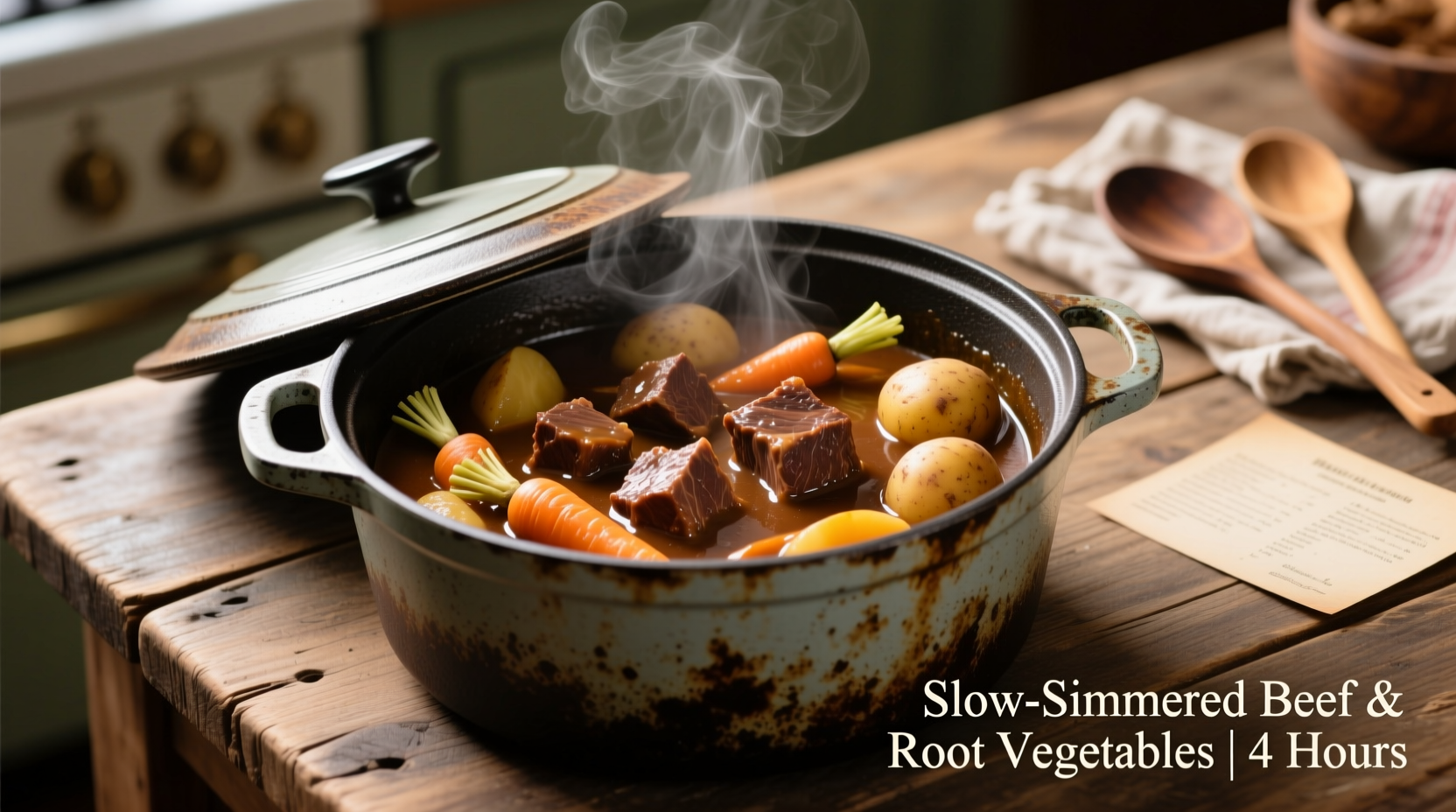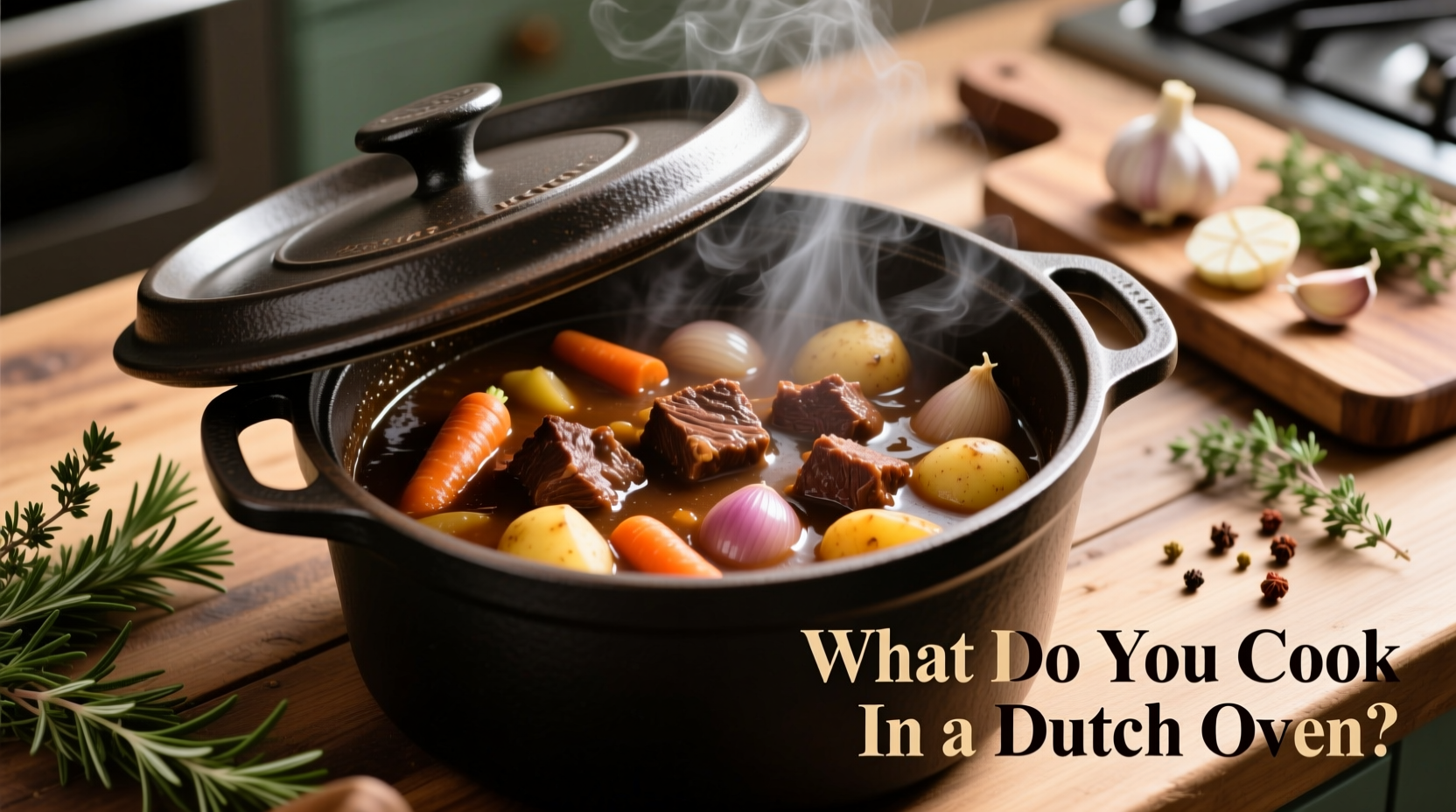Why Your Dutch Oven Is the Most Versatile Pot in Your Kitchen
That heavy cast-iron pot gathering dust in your cupboard? It's time to unleash its full potential. Dutch ovens aren't just for camping trips—they're the secret weapon of professional chefs for achieving restaurant-quality results at home. The unique thermal properties of cast iron (which maintains temperatures within ±15°F according to USDA food safety guidelines) create the perfect environment for transforming ordinary ingredients into extraordinary meals.

Your Complete Dutch Oven Cooking Guide by Dish Type
Understanding what to cook in a Dutch oven starts with recognizing how its design excels at specific cooking techniques. Unlike standard pots, Dutch ovens provide:
- Superior heat retention for consistent temperature control
- Heavy lid that traps moisture while allowing slight evaporation
- Even heat distribution that prevents hot spots
- Versatility for stovetop-to-oven transitions
Perfect Soups and Stews for Dutch Oven Cooking
When searching what do you cook in a dutch oven for weeknight dinners, hearty soups and stews should be your first choice. The heavy construction prevents scorching during long simmers—a common problem with thinner pots.
| Dish Type | Optimal Temp | Cooking Time | Pro Tip |
|---|---|---|---|
| Beef stew | 325°F (oven) | 2.5-3 hours | Sear meat in batches to prevent steaming |
| Chicken soup | Simmer on stove | 1.5 hours | Add delicate herbs in last 15 minutes |
| Cioppino | Medium-low heat | 45 minutes | Add seafood in order of cooking time |
Braised Meats That Shine in Cast Iron
Professional chefs consistently choose Dutch ovens for what to cook in a dutch oven for special occasions. The tight-sealing lid creates a mini-oven environment that tenderizes tough cuts through controlled steam circulation. According to the Smithsonian Institution, Dutch ovens have been the preferred vessel for braising since the 17th century due to their unmatched heat retention.
Top braising candidates:
- Short ribs - Cook at 300°F for 3 hours for fall-off-the-bone texture
- Pork shoulder - Low and slow at 275°F yields perfect pulled pork
- Oxtail - Requires 4+ hours but transforms into gelatin-rich perfection
Remember: Always sear meats thoroughly before braising. The Maillard reaction creates complex flavor compounds that simmering alone can't achieve.
Baking Bread with Professional Results
One of the most surprising what can you cook in a dutch oven applications is artisan bread baking. The enclosed environment mimics professional steam injection ovens by trapping the dough's natural moisture.
For perfect crusty boules:
- Preheat empty Dutch oven at 450°F for 30 minutes
- Carefully transfer shaped dough into hot pot
- Cover and bake 20 minutes
- Uncover and bake 15-20 minutes more
This technique produces professional-quality oven spring and crackling crust without specialized equipment. The American Institute of Baking confirms that the sudden temperature change when uncovering creates the dramatic crust expansion home bakers seek.
One-Pot Meals That Save Time and Dishes
When answering what to cook in a dutch oven for busy weeknights, one-pot wonders deliver maximum flavor with minimal cleanup. The even heating prevents the scorching that often ruins rice dishes in standard pots.
Try these foolproof combinations:
- Chicken and rice - Brown thighs first, then add rice, broth, and aromatics
- Shakshuka - Simmer tomatoes and peppers, then crack eggs directly into sauce
- Paella - Use saffron-infused broth and layer ingredients strategically
Dutch Oven Desserts You Never Knew Were Possible
Expand your what can you cook in a dutch oven besides savory dishes repertoire with these sweet options:
- Cobbler - Fruit filling on bottom, biscuit topping on top
- Fruit crisp - Oat topping creates perfect texture contrast
- Baked apples - Core apples, fill with butter and spices
For best results, reduce oven temperature by 25°F compared to standard recipes to prevent over-browning.
Essential Dutch Oven Cooking Techniques
Master these fundamentals to maximize your what do you cook in a dutch oven possibilities:
Temperature Control Mastery
Cast iron's thermal mass works both for and against you. Preheat gradually to avoid thermal shock. The Materials Education Resource Center notes that sudden temperature changes exceeding 200°F can cause cast iron to crack. Always adjust heat gradually.
Care and Maintenance for Longevity
Proper care ensures decades of service:
- Avoid soap on seasoned cast iron (use hot water and brush)
- Dry thoroughly after washing
- Apply thin oil layer after cleaning
- Store with paper towel inside to absorb moisture
Common Dutch Oven Mistakes to Avoid
Even experienced cooks make these errors when exploring what to cook in a dutch oven:
- Overcrowding the pot - Reduces browning and steams food
- Using high heat unnecessarily - Cast iron retains heat exceptionally well
- Ignoring preheating requirements - Essential for baking applications
- Using metal utensils on enameled versions - Can chip the coating
Remember that Dutch ovens excel at low-and-slow cooking. Reserve high-heat applications for specific techniques like initial searing.
Unlock Your Dutch Oven's Full Potential
Understanding what to cook in a Dutch oven transforms this humble pot into your most valuable kitchen tool. From Sunday roasts to weekday soups, the consistent heat distribution and moisture control deliver results other cookware can't match. Start with the basics—braises and stews—then expand to baking and one-pot meals as you gain confidence. Your Dutch oven isn't just another pot; it's a complete cooking system that rewards attention to technique with extraordinary results.











 浙公网安备
33010002000092号
浙公网安备
33010002000092号 浙B2-20120091-4
浙B2-20120091-4